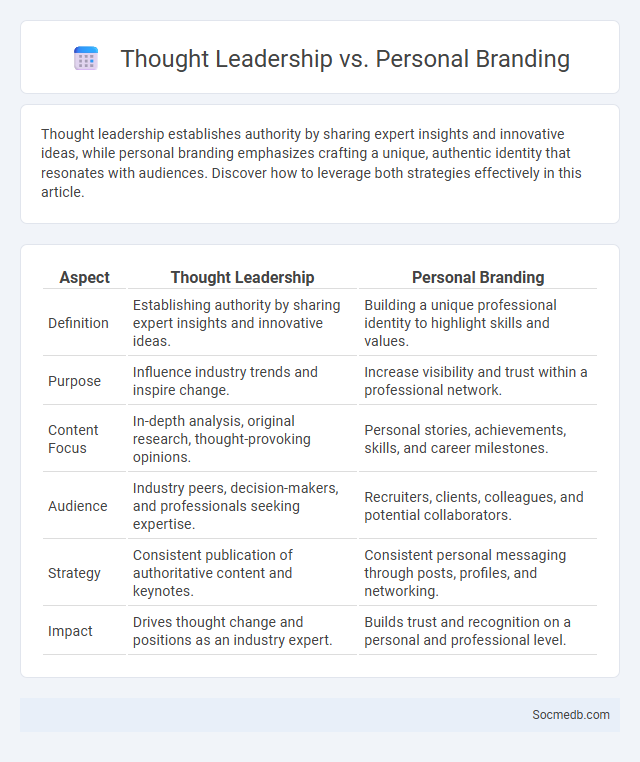
Photo illustration: Thought Leadership vs Personal Branding
Thought leadership establishes authority by sharing expert insights and innovative ideas, while personal branding emphasizes crafting a unique, authentic identity that resonates with audiences. Discover how to leverage both strategies effectively in this article.
Table of Comparison
| Aspect | Thought Leadership | Personal Branding |
|---|---|---|
| Definition | Establishing authority by sharing expert insights and innovative ideas. | Building a unique professional identity to highlight skills and values. |
| Purpose | Influence industry trends and inspire change. | Increase visibility and trust within a professional network. |
| Content Focus | In-depth analysis, original research, thought-provoking opinions. | Personal stories, achievements, skills, and career milestones. |
| Audience | Industry peers, decision-makers, and professionals seeking expertise. | Recruiters, clients, colleagues, and potential collaborators. |
| Strategy | Consistent publication of authoritative content and keynotes. | Consistent personal messaging through posts, profiles, and networking. |
| Impact | Drives thought change and positions as an industry expert. | Builds trust and recognition on a personal and professional level. |
Introduction to Thought Leadership and Personal Branding
Thought leadership establishes your expertise and authority in a specific industry, generating trust and influence through valuable insights and innovative ideas. Personal branding shapes your unique identity, highlighting your skills, values, and professional story to distinguish you from competitors. Using strategic content and consistent messaging on social media, you can enhance your reputation and expand your network effectively.
Defining Thought Leadership
Thought leadership in social media establishes your authority by consistently sharing insightful, original content that addresses your audience's needs and challenges. By positioning yourself as an expert, you build trust and influence within your niche, fostering deeper engagement and expanding your reach. Your ability to provide valuable perspectives and drive meaningful conversations sets you apart as a go-to resource in the digital landscape.
Understanding Personal Branding
Personal branding on social media involves strategically showcasing Your unique skills, values, and personality to establish a recognizable online presence. Consistent content, authentic engagement, and targeted audience interactions enhance Your credibility and influence across platforms like LinkedIn, Instagram, and Twitter. Leveraging analytics tools helps refine Your brand messaging to maximize impact and reach.
Thought Leadership vs Personal Branding: Core Differences
Thought leadership emphasizes showcasing your expertise and insights to influence industry trends and establish authority, while personal branding centers on building a consistent, authentic image that reflects your personality and values. Your thought leadership content should provide valuable, innovative ideas that address challenges in your field, whereas personal branding involves crafting a relatable presence that connects with your audience on a more personal level. Understanding these core differences helps you strategically leverage social media to strengthen your professional reputation and foster meaningful engagement.
The Purpose of Thought Leadership
Thought leadership on social media positions Your brand as an industry authority by sharing insightful, valuable content that addresses key challenges and trends. Engaging consistently with your audience through expert opinions and innovative ideas fosters trust and influence in your niche. This strategic approach boosts visibility, drives meaningful conversations, and strengthens Your professional reputation online.
The Role of Personal Branding in Modern Business
Personal branding plays a crucial role in modern business by establishing Your unique identity and credibility in a crowded digital marketplace. It enhances trust and recognition among potential clients, boosting customer loyalty and competitive advantage. Leveraging consistent, authentic social media presence directly impacts business growth and professional opportunities.
Strategies for Building Thought Leadership
Establishing thought leadership on social media requires consistent sharing of industry insights and original content tailored to your target audience's interests. Engaging actively with followers and influencers fosters trust and positions you as a credible expert. Leveraging platforms like LinkedIn and Twitter with strategic hashtags and interactive posts amplifies reach and enhances authority within your niche.
Tips for Developing an Authentic Personal Brand
Developing an authentic personal brand on social media requires consistent storytelling that reflects your core values and unique voice. Engage genuinely with your audience by sharing personal insights and experiences, fostering trust and loyalty. Utilize platforms like Instagram, LinkedIn, and Twitter to showcase your expertise and build a cohesive online presence aligned with your professional goals.
Integrating Thought Leadership with Personal Branding
Integrating thought leadership with personal branding elevates your social media presence by showcasing expertise while building authentic connections with your audience. Consistently sharing insightful content, engaging in industry conversations, and highlighting your unique perspective strengthens credibility and trust. This approach positions you as an influential voice, attracting opportunities and expanding your professional network.
Choosing the Right Path: Which Suits Your Goals?
Selecting the right social media platform hinges on aligning its audience demographics and content format with your specific goals, whether brand awareness, lead generation, or customer engagement. Analyzing user behavior on platforms like Instagram for visual storytelling or LinkedIn for professional networking ensures targeted impact and resource efficiency. Understanding platform algorithms and leveraging data analytics refines content strategy to maximize reach and conversion rates.
 socmedb.com
socmedb.com